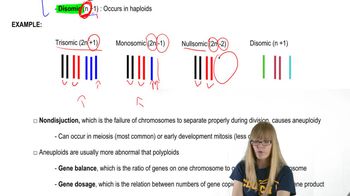Assume that on rare occasions the attached X chromosomes in female gametes become unattached. Based on the parental phenotypes in Problem 12, what outcomes in the F₁ generation would indicate that this has occurred during female meiosis?
Table of contents
- 1. Introduction to Genetics51m
- 2. Mendel's Laws of Inheritance3h 37m
- 3. Extensions to Mendelian Inheritance2h 41m
- 4. Genetic Mapping and Linkage2h 28m
- 5. Genetics of Bacteria and Viruses1h 21m
- 6. Chromosomal Variation1h 48m
- 7. DNA and Chromosome Structure56m
- 8. DNA Replication1h 10m
- 9. Mitosis and Meiosis1h 34m
- 10. Transcription1h 0m
- 11. Translation58m
- 12. Gene Regulation in Prokaryotes1h 19m
- 13. Gene Regulation in Eukaryotes44m
- 14. Genetic Control of Development44m
- 15. Genomes and Genomics1h 50m
- 16. Transposable Elements47m
- 17. Mutation, Repair, and Recombination1h 6m
- 18. Molecular Genetic Tools19m
- 19. Cancer Genetics29m
- 20. Quantitative Genetics1h 26m
- 21. Population Genetics50m
- 22. Evolutionary Genetics29m
6. Chromosomal Variation
Chromosomal Mutations: Aneuploidy
Problem 17a
Textbook Question
Drosophila may be monosomic for chromosome 4, yet remain fertile. Contrast the F₁ and F₂ results of the following crosses involving the recessive chromosome 4 trait, bent bristles:
monosomic IV, bent bristles x diploid, normal bristles
 Verified step by step guidance
Verified step by step guidance1
Determine the genetic makeup of the parents: The monosomic IV, bent bristles parent has one copy of chromosome 4 with the recessive allele (b) for bent bristles. The diploid, normal bristles parent has two copies of chromosome 4, both carrying the dominant allele (B) for normal bristles.
Set up the F₁ cross: The monosomic parent can only contribute one chromosome 4 with the recessive allele (b). The diploid parent can contribute either of its two dominant alleles (B). Thus, the F₁ offspring will inherit one chromosome 4 from the monosomic parent and one from the diploid parent, resulting in a heterozygous genotype (Bb) for all F₁ individuals.
Predict the phenotype of the F₁ generation: Since the dominant allele (B) masks the effect of the recessive allele (b), all F₁ individuals will exhibit the normal bristles phenotype.
Set up the F₂ cross: The F₁ individuals (Bb) are crossed with each other. This involves a typical Mendelian dihybrid cross where each parent can contribute either the dominant allele (B) or the recessive allele (b).
Determine the F₂ genotypic and phenotypic ratios: Use a Punnett square to calculate the possible combinations of alleles in the F₂ generation. The expected genotypic ratio will be 1 BB : 2 Bb : 1 bb, and the phenotypic ratio will be 3 normal bristles : 1 bent bristles, as the recessive phenotype (bent bristles) only appears in individuals with the bb genotype.
 Verified video answer for a similar problem:
Verified video answer for a similar problem:This video solution was recommended by our tutors as helpful for the problem above
Video duration:
1mPlay a video:
Was this helpful?
Key Concepts
Here are the essential concepts you must grasp in order to answer the question correctly.
Monosomy
Monosomy refers to the condition where an organism has only one copy of a particular chromosome instead of the usual two. In Drosophila, being monosomic for chromosome 4 means that there is only one copy of this chromosome present, which can affect gene expression and phenotypic traits. Despite this, some organisms can still be fertile, as seen in the case of Drosophila, where certain traits may not be lethal even in a monosomic state.
Recommended video:
Guided course

Aneuploidy
Recessive Traits
Recessive traits are characteristics that are expressed only when an individual has two copies of the recessive allele. In the context of the bent bristles trait in Drosophila, this means that a fly must inherit the recessive allele from both parents to exhibit bent bristles. If the fly has at least one dominant allele for normal bristles, the normal phenotype will be expressed instead.
Recommended video:
Guided course

Traits and Variance
F₁ and F₂ Generations
The F₁ generation is the first filial generation resulting from a cross between two parental lines, while the F₂ generation is produced by interbreeding individuals from the F₁ generation. In genetic crosses, analyzing the phenotypic ratios in these generations helps to understand inheritance patterns. For the given crosses, observing the F₁ and F₂ results will reveal how the monosomic condition affects the expression of the bent bristles trait compared to the diploid normal bristles.
Recommended video:
Guided course

F Factor and Hfr
Related Videos
Related Practice
Textbook Question
388
views


